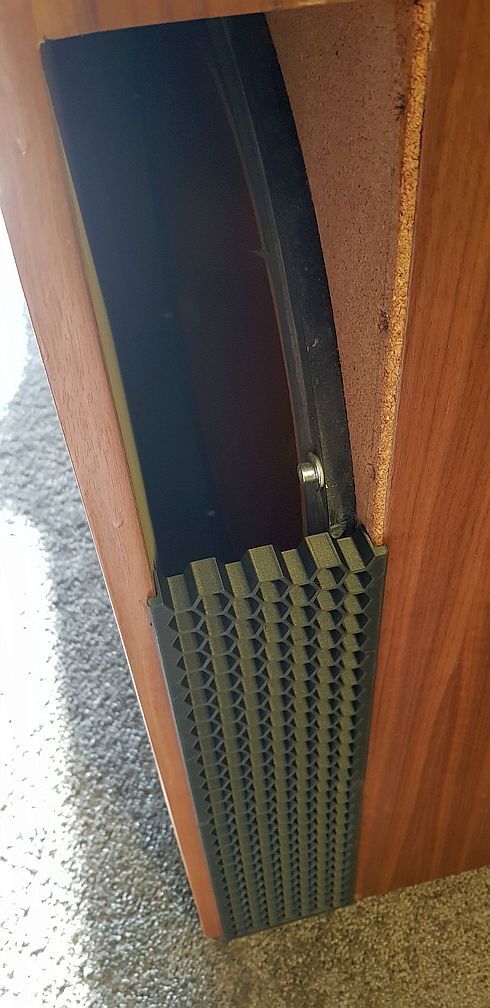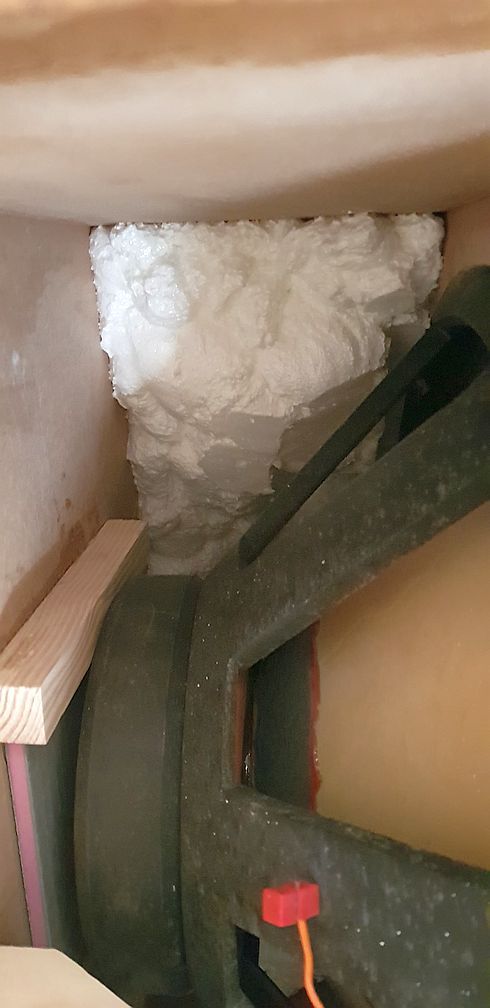@Daihetz - you can surely change geometry and get something in between a Ripole and a simple open baffle. But you should always look for some linearization of frequency response however.
Damping the efficiency away is then not necessary. Any type of acoustical resistance due to damping materials like wadding very close to the driver can affect the sound because its effect can be non-linear.
@Kallbo - I found out that not only the principle of enclosure has some impact on the sound of a subwoofer:
the driver:
- stiffness of the cone - the stiffer the better
- electrical damping by the amplifier and cable diameter - there is a difference between 1,5 mm2 and 6 mm2 if the cable is not very short
the enclosure:
- very good woodwork or
- combining wood with concrete
I prefer some thin plywood of 12 to 16 mm and then I put into the enclosure side after side concrete of 1cm to 1.5 cm and let it dry for 1 to 3 days before going on with the other side of the baffle.
This seems to have the same acoustical effect like some other very advanced loudspeaker enclosure designs (sandwich enclosure, very well bracing and others)
I will try out one day an open baffle design
Damping the efficiency away is then not necessary. Any type of acoustical resistance due to damping materials like wadding very close to the driver can affect the sound because its effect can be non-linear.
@Kallbo - I found out that not only the principle of enclosure has some impact on the sound of a subwoofer:
the driver:
- stiffness of the cone - the stiffer the better
- electrical damping by the amplifier and cable diameter - there is a difference between 1,5 mm2 and 6 mm2 if the cable is not very short
the enclosure:
- very good woodwork or
- combining wood with concrete
I prefer some thin plywood of 12 to 16 mm and then I put into the enclosure side after side concrete of 1cm to 1.5 cm and let it dry for 1 to 3 days before going on with the other side of the baffle.
This seems to have the same acoustical effect like some other very advanced loudspeaker enclosure designs (sandwich enclosure, very well bracing and others)
I will try out one day an open baffle design
Yes, i tried dif. amps, cables, crossovers,(Behringer, DBX, Deqx) too.
The XTZ came out as the winner, for now 🙂
Build the ripoles with tre layers of 16mm plywood: plywood-sand-plywood.
Robert Bastanis said this was not necessary, but no movement here…..
It’s all about synergy in your system. That what cost most is not always best.
You learn this with 40 years in this hobby.
The XTZ came out as the winner, for now 🙂
Build the ripoles with tre layers of 16mm plywood: plywood-sand-plywood.
Robert Bastanis said this was not necessary, but no movement here…..
It’s all about synergy in your system. That what cost most is not always best.
You learn this with 40 years in this hobby.
T
A more wideband Ripole sub can be achieved using multiples of more modestly sized (e.g. 12" class or less) drivers. Drivers are best used in opposed pairs, so that the vibration is largely canceled out, and with one driver's cone moving in the opposite direction as the other to reduce even order harmonic distortion. For example, the original Ripole used two 12" Peerless drivers and it's not bad (for a Ripole at least). Instead of the resonance occurring at F=138Hz it's more like F=200-250Hz so you can use the sub up to 100Hz or so, which is more reasonable and useful. By using multiple (e.g. four) 10" drivers you can further increase the upper end of the passband and the resulting system is still compact and more like a "cube" in shape, with the ripoles stacked together.
Obviously, a smaller driver means a shallower cavity and hence higher resonance. Are you implying there is an added benefit to opposing drivers other than the cancellation of vibrations? One would tend to make the cavity wider, which would add to its effective length, thereby pushing the resonance down.
I really wonder if a moderate V-baffle is the way to go, e.g. 20° instead of the 45° of the LX521 sub. This would result in better vibration cancellation while hopefully retaining a low Q resonance.
The plan of the Ripole with the dimensions in centimeters.
https://goopics.net/i/h9uucn
I first built a larger prototype. I then looked for the best curve with 1cm plates in the tunnels.
I don't get the meaning of that drawing and your explanation. What is that diagonal grid? Did you use flexible foam bords that fold around the rear 180° of the frame so that the back of the cavity is a semi-circle sitting right at the edge of the driver? Or is this absorptive foam?
Thanks for the clarification. You don't do thing half way, do you? 🙂
Seriously, the foam in the back will change the cavity resonance, even if it is 100% reflective in the bass region (which I doubt). It won't do much do increase rigidity because the walls do not have much leverage so close to the back wall.
The grilles are visually nice. I doubt they change the air flow a lot. I'd be concerned about potential rattle if these things are not glued to the wood frame.
Seriously, the foam in the back will change the cavity resonance, even if it is 100% reflective in the bass region (which I doubt). It won't do much do increase rigidity because the walls do not have much leverage so close to the back wall.
The grilles are visually nice. I doubt they change the air flow a lot. I'd be concerned about potential rattle if these things are not glued to the wood frame.
Obviously, a smaller driver means a shallower cavity and hence higher resonance. Are you implying there is an added benefit to opposing drivers other than the cancellation of vibrations? One would tend to make the cavity wider, which would add to its effective length, thereby pushing the resonance down.
I really wonder if a moderate V-baffle is the way to go, e.g. 20° instead of the 45° of the LX521 sub. This would result in better vibration cancellation while hopefully retaining a low Q resonance.
When you have 2*N drivers they can be arranged so that when the cone of one of the pair moves towards the magnet the cone of the other one of the pair moves away from the magnet. This will largely cancel even order harmonics so distortion is lowered for free.
In Linkwitz's LX521 woofer section the two drivers do not completely cancel the inertial of the moving mass, and so there is still vibration. I think the cancellation is something like 50%, which isn't bad. But SL decided there was still too much, so he built a "bridge" to support the mids and tweeters. The bridge mechanically decouples the woofers from the rest of the speaker.
In my projects I use wired to hang drivers without baffles and the wires do an excellent job of decoupling the drivers from each other.
Yes, I was aware of the distortion cancellation, my question was about the resonance of the cavity. So I take it using 2N drivers does not move the resonance up. If anything, it goes down because the slot usually is wider?
Thanks for the clarification. You don't do thing half way, do you? 🙂
The grilles are visually nice. I doubt they change the air flow a lot.
The grilles change the air flow. But this is not a good idea.
Comparison with and without grids.
Green without grids and blue with grids
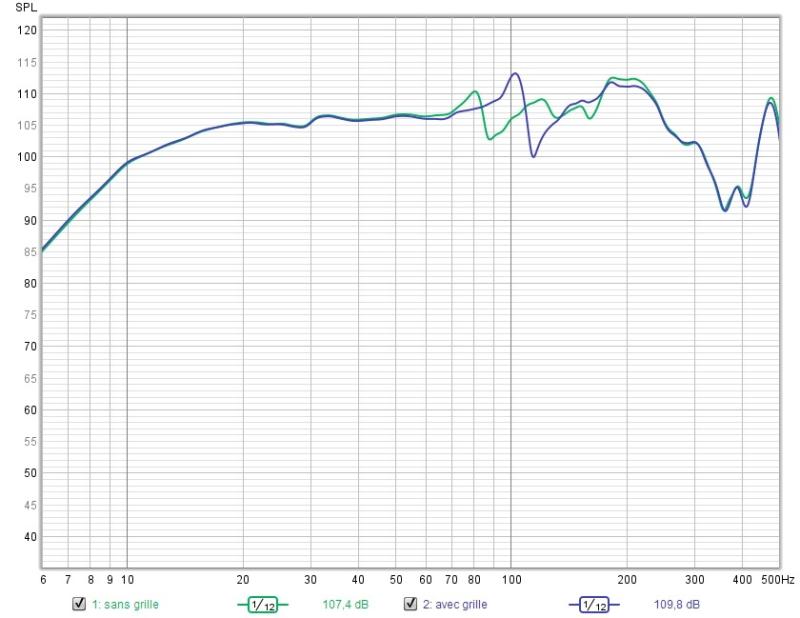
Distortion without grids.
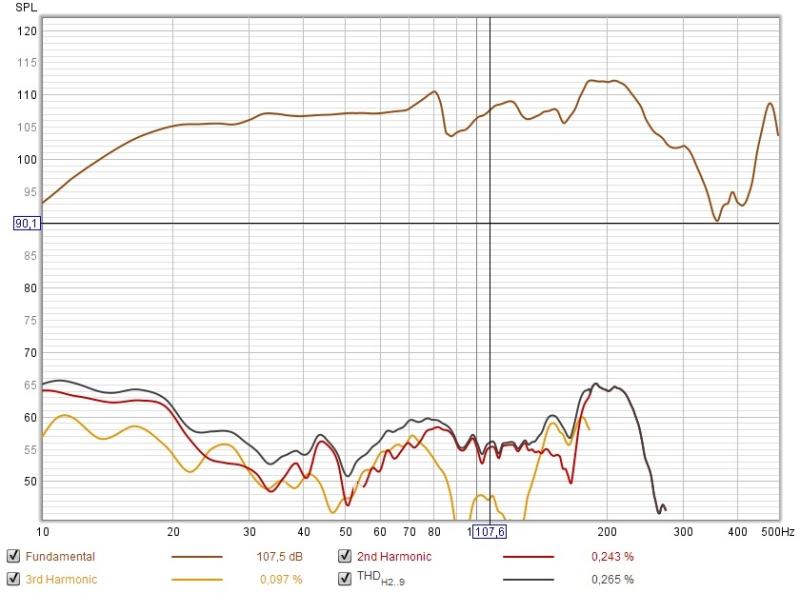
Distortion with grids.
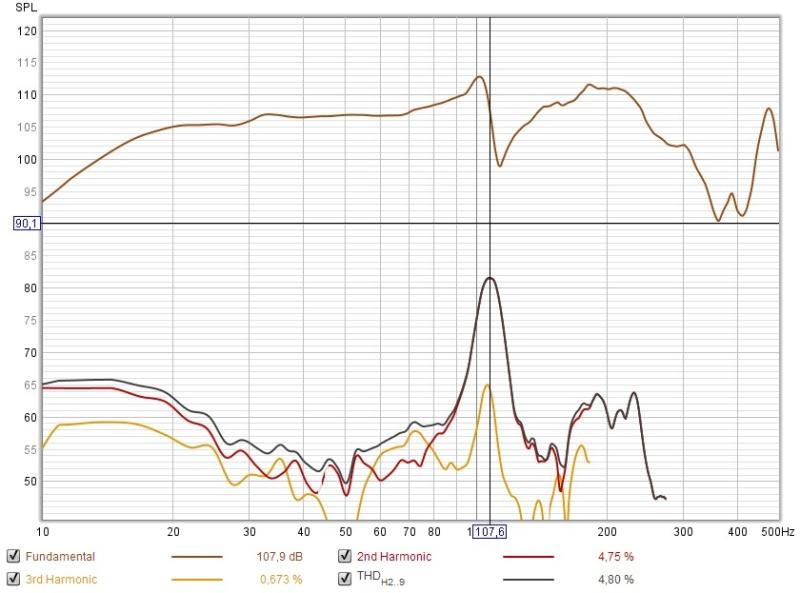
- Home
- Loudspeakers
- Subwoofers
- 21“ in a Ripole subwoofer
